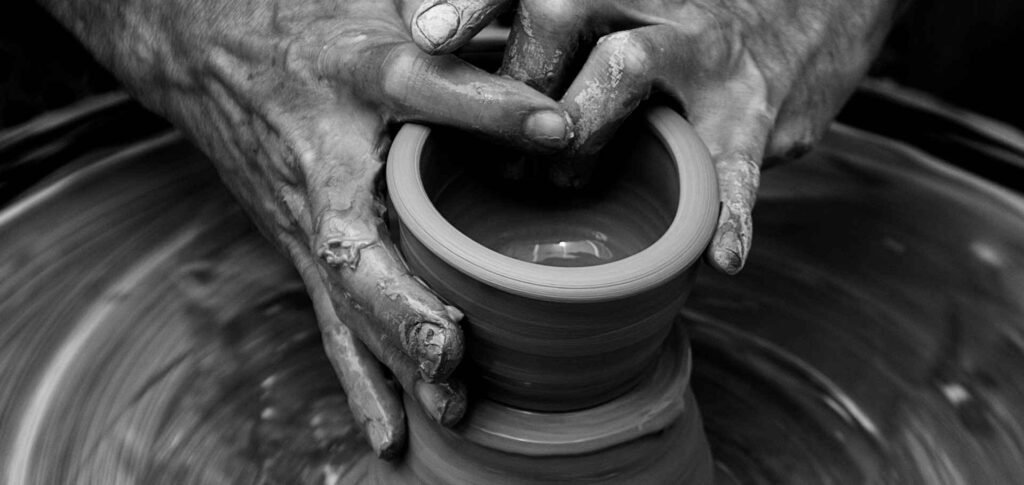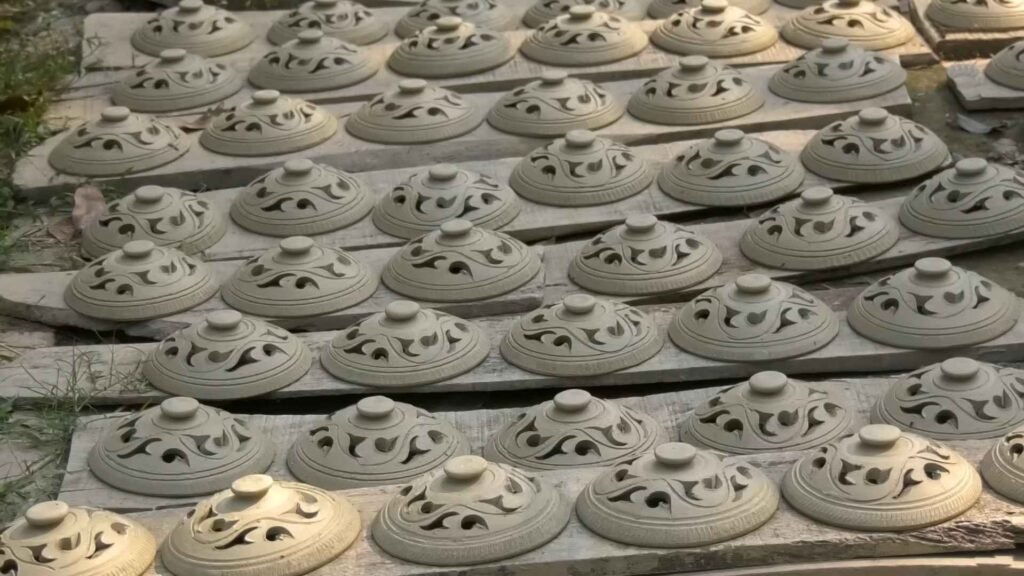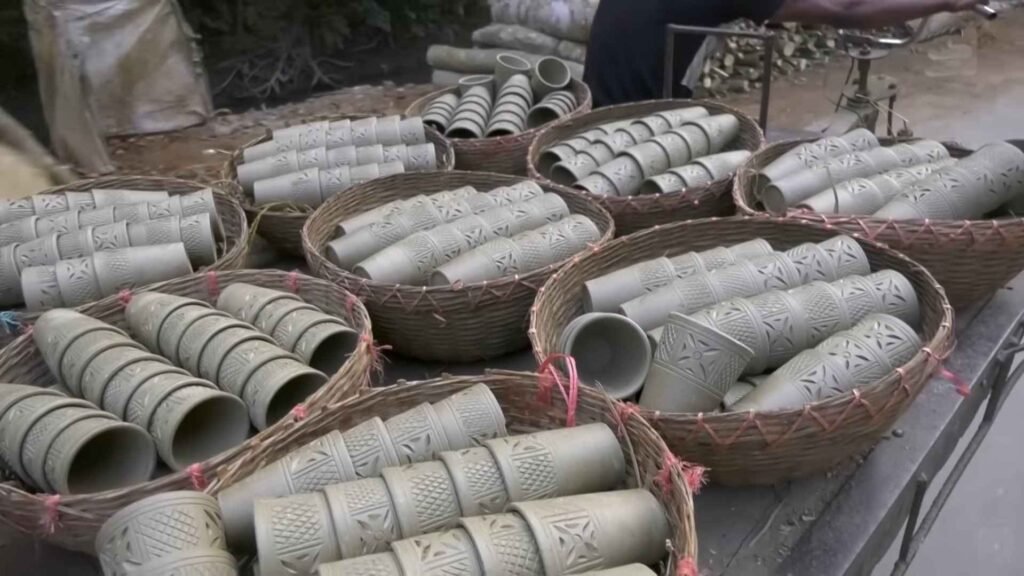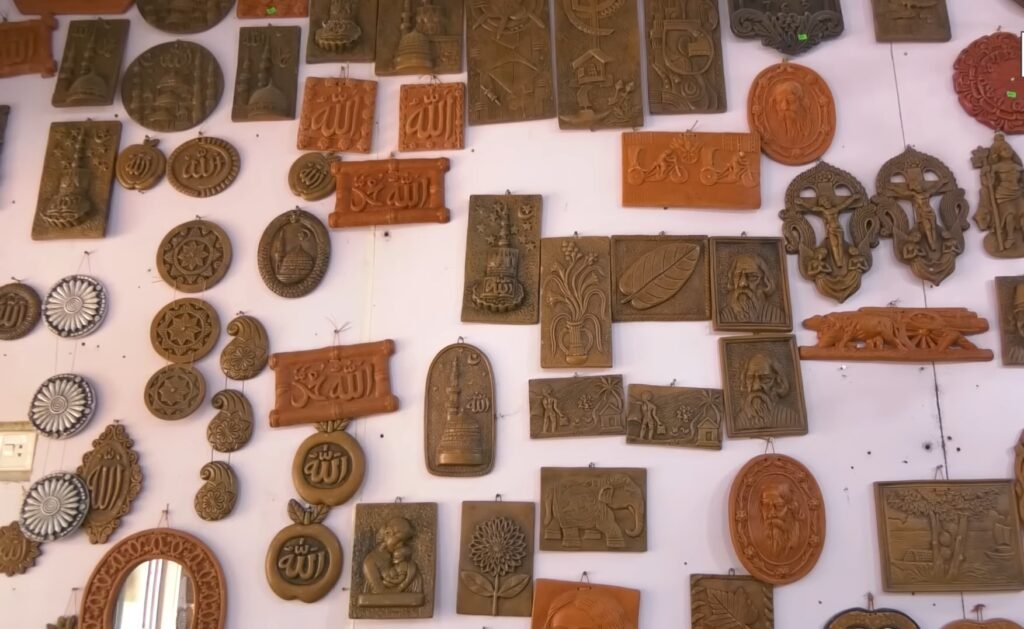Ashuganj’s Century-Old Rice Market Home / BOC Ghat sits about...
Read MoreThe Art of Clay : A 3,500-Year-Old Legacy of Pottery in Bangladesh
Madanpur Palpara in Bangladesh preserves a 3,500-year-old pottery tradition, where skilled artisans craft exquisite clay products. This heritage-rich village continues to uphold the country’s ancient craftsmanship with modern techniques.
The Art of Clay : A 3,500-Year-Old Legacy of Pottery in Bangladesh

In the southernmost part of Bangladesh, the village of Palpara in Madanpur Union of Bauphal Upazila, Patuakhali, has preserved the centuries-old tradition of pottery. The potters of Palpara use the finest clay in Patuakhali for their craft. To make the sticky clay suitable for pottery, it is first kneaded into a dough by treading on it with feet.
Typically, a suitable clay mixture is made by combining one part sand with two parts black sticky clay. In riverine Bangladesh, soil plays a fundamental role in geological formations. For generations, potters have been using this natural resource to create pottery.
To keep up with changing times, most potter households in Palpara, Madanpur, have now turned into commercial pottery workshops. Depending on the type of pottery being made, the first step involves measuring the clay dough on a balance scale and shaping it into a round ball by hand.
Steps to Make Clay Product
From shaping the clay into a ball to marketing the finished pottery, every step is carefully carried out by the skilled potters of this region. Instead of traditional hand-driven wheels, they now use motorized potter’s wheels. Placing the clay on the spinning wheel, the potter skillfully molds it into the desired shape with precise hand movements.
The use of semi-mechanized technology allows for the production of a large number of pottery items in a short time. Transforming ordinary clay into finely crafted pottery showcases the incredible creativity of the potter.
The combination of craftsmanship and mechanized tools has resulted in more refined and flawless pottery. Each potter’s wheel produces different types of clay products. Once shaped, the freshly made pottery is initially dried to harden, arranged neatly on open shelves in rows.

Golden History
The potters of Madanpur Palpara, inheriting their craft through generations, consider pottery not just a profession but an art. This ancient tradition in Bangladesh dates back over 3,500 years, and the artisans of Palpara continue to uphold its legacy.
Preserving the essence of local heritage, this village is located 30 km northeast of Patuakhali and 2 km from Bauphal. Among the 500 families engaged in pottery, 60 families in Madanpur remain dedicated to this timeless craft.
Molds or dies are used to create plates of specific sizes. The plate-making wheel is slightly different from other wheels. After shaping, the raw plates with dies are left in the open air to dry. Items that require designs are dried under controlled light and air using a plastic cover. Not just plates or pots, but home décor pieces and children’s toys are also made using dies. Once partially hardened in the open air, they are taken to the drawing section for designing.

Design
First, the surface of the pot is smoothed by scraping, and lines are drawn according to the design. Over time, variety has emerged in pottery. Workloads have increased, as have busyness and productivity. Due to the growing demand for decorative pottery, everyday items like basins, bowls, pots, and pitchers are now produced less.
On scraped and cleaned pots, skilled artisans from the design department craft intricate patterns. When ordinary pottery is adorned with engraved designs, it becomes handicraft. With the support of organizations like BSCIC, the Institute of Fine Arts, and Aaron, modernization and embellishment of pottery have evolved.
Artists decorate pottery by combining more than 20 different designs. Although technology plays a role in some cases, pottery remains primarily a handcrafted art form.
While a portion of the produced goods are marketed by the artisans themselves, most products are sold through buying houses like Aaron, Hit Bangladesh, and Dhaka Handicrafts. The handled water jug is a versatile item—it can be used for storing water or displayed as a showpiece. Flower pots are among the most in-demand products, highly valued in urban areas.
Production and marketing
At the Madanpur pottery workshops, work begins at 7 AM and continues until 6 PM. Except for shaping pots on the spinning wheel, all other tasks are carried out by women. Throughout the day, various pottery items dry under the sun in the courtyards of different households in Palpara.
Not only in Madanpur, but also in Kanakdia, Boga, and Bauphal Sadar Union, pottery production follows a step-by-step process.
On sunny days, pottery dries very quickly. On average, raw pottery is sun-dried for 10 to 12 hours before the cleaning process begins. A damp cloth is used to wipe away any dust, sand, or excess clay, ensuring a smooth finish.
Afterward, a dry cloth is used for a final wipe, making the pottery exceptionally smooth. However, due to the dominance of plastic, melamine, and metal products, the demand for eco-friendly pottery has declined, putting this traditional craft at risk. By focusing on modernization, diversification, and quality assurance, Palpara’s potters have managed to survive in a competitive market.

A layer of color is then applied using a mixture of lac, washing soda, zinc, and tree bark, which enhances the smoothness and aesthetic appeal of the pottery. Once the color dries, intricate hand-drawn designs are carefully etched onto each piece.
With artistic precision, potters create delicate patterns on plates, teacups, saucers, bowls, and mugs. The decorative pottery of Madonpur’s Palpara is known for its symmetrical shape, smooth texture, and long-lasting durability. These beautifully crafted pieces are not just ornamental but also fully functional, reflecting the timeless folk art tradition of Bengal.

Kiln Room
After the coloring and design work has dried in the sun, the next step is preparing for the firing process. The pottery is fired in a special kiln. The potters arrange the pottery in layers on top of the large kiln.
There are numerous such kilns scattered across Madanpur. To fire the pots, dry wood and tree logs are needed in large quantities. The kiln has a compartment where the pottery is stacked on top, and a door at the bottom for fueling the fire.
Continuous wood and sometimes rice husks are used to keep the fire burning. The intense heat from the fire causes smoke to escape through the cracks in the kiln. The heat is contained within due to the straw, husks, and mud layers covering the kiln, preventing the heat from escaping. The pottery remains in the kiln for around 12 to 14 hours in this blazing fire.
Marketing
After being fired in the kiln, the clay pots attain their permanent shape. The fired pottery is known as ceramics in English. The term ceramic comes from the Greek word “keramos,” meaning “potter’s clay.” Once the pots cool down, the process of unloading begins, followed by marketing.
The pottery from Madanpur’s Palpara is created through various methods. Local demand is met, and the products are sold nationwide through wholesalers, while buying houses help in exporting them abroad. These high-quality products bring in nearly 50 crore taka annually from foreign sales. The local shops sell pottery both directly and via online orders. Customers, including retail and wholesale traders from across the country, visit here to buy pottery that suits their preferences.
The potters of Palpara create stunning vases with eye-catching designs. These are not only attractive but also durable. Each product reflects the artistry and craftsmanship involved. The variety of products is impressive, and the collection of decorative showpieces for home decoration is equally enchanting.

Conclusions
Each of the sales centers here serves as a showcase for Bangladesh’s traditional pottery craftsmanship. In the packaging section, workers wrap and package the products in paper. From here, the pottery is exported to 24 countries across Asia and Europe, including the United States, United Kingdom, France, Germany, and Italy.
Bangladesh Army in the era of Bangladesh 2.0
Bangladesh Army in the era of Bangladesh 2.0 Home /...
Read MoreNafakhum Waterfall: Hidden Water Mystery
Nafakhum Waterfall: Hidden Water Mystery Home / The Chittagong Hill...
Read MoreGovernment Promotes China Investment In Bangladesh 2.0
Home / Government Promotes China Investment In Bangladesh 2.0 ...
Read More


